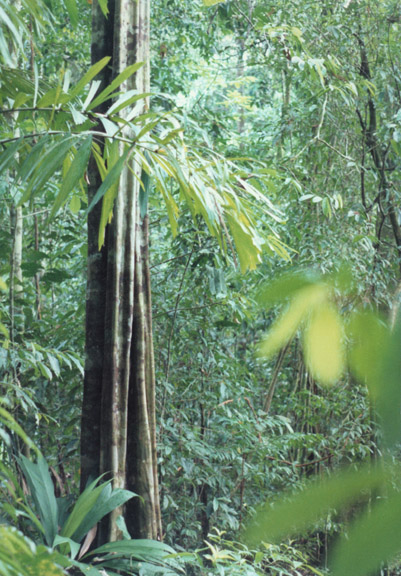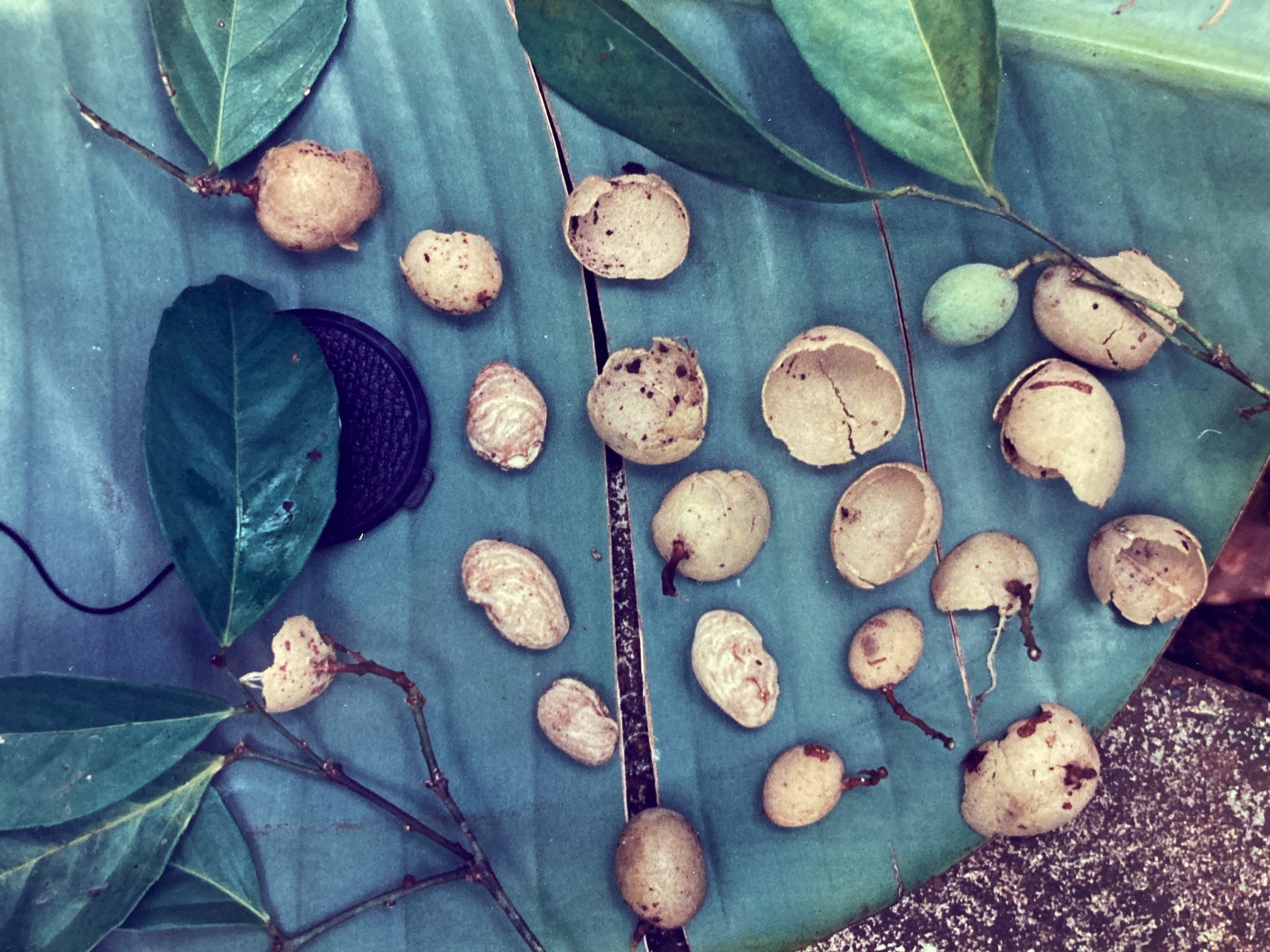Lecointea amazonica Ducke
Fabaceae CAJA, COSTILLA DE DANTA
Rare evergreen canopy tree (25-35 m) distributed thinly and solitarily throughout most very humid primary forest habitats along the Pacific Slope. Caja is perhaps the most unique, arguably the most esthetic, and ly one of the most interesting of all Costa Rican tree species. Its unlikely, deeply channeled bole and strange, egg-like fruits underscore the incredible diversity to be found in tropical humid forests while the tree’s extreme rarity makes poignant the need to preserve them. Worth seeking out, Caja’s unique botanical features facilitate its identification.
Description: Caja’s trunk (50 cm) is among the most irregular of any tropical forest tree. Its contour resembles that of a circular, green curtain with closely spaced and deeply impressed, rounded folds. Most pronounced at the tree’s base, these folds continue along the entire length of the bole, becoming shallower with height. Caja trunks are mostly straight, although they show some angular bending as they rise to the canopy. Once there, a moderate number of short, angular limbs form a narrow, often irregular, but thick crown. The bole is clad in smooth, thin, greenish bark (frequently mottled by lighter lichens).
Leaves (9 by 4 cm) are simple, alternately arranged, smooth, and leathery. Their elliptical outline tapers to a blunt (often absent) drip-tip at one end and to a short petiole (4 mm) at the other. Blade margins are shallowly serrate and their outermost fringes form a fine, downwardly-turned lip. Most leaves are slightly falcate (longitudinally curving) as well. Trees renew 10-20% of their foliage in June and again in December.
Flowers emerge from leaf axils in short racemes (4 cm). The creme-colored blossoms remain close to the twigs and fill out the spaces between the leaves – accenting them with a splash of white. Irregular in shape, each blossom (8 mm long) is slipper-shaped with a tubular calyx, ten short stamens, and a longer central pistil that emerges from the flower bud well before the perianth is open. The five-part corolla is dominated by a broad, hood-like superior petal that envelopes and covers the four remaining, narrow petals. Flowering periods occur approximately every two years and, though prolific and synchronized, are short-lived (10 day) events occurring in early April.
Fruits are visible by May and reach their full size in July, maturing as they change color from pale green to off-white in October. Each is an indehiscent, fleshy pod sharing the size, ovoid shape, texture, and color of a small (2.5-3 cm) bird’s egg. Even the outer “shell” of the fruit resembles an egg in its thinness and brittle consistency. Inside, the large (2 cm) central seed is surrounded by a layer of stiff, white, juicy pulp. (This pulp, when unripe, smells strongly of almond extract).Distinctive in its own right, the seed is elliptical, somewhat flattened, and grooved by many shallow, interconnecting creases. Harvests begin in October and continue into early November. Seeds germinate rapidly – within a couple of weeks of fruit-fall.
Similar Species: Thanks to its wonderfully sculpted trunk, Caja is about as unique and as easy to identify as a tree species can be. Fosforillo (Chomelia microloba) also has a highly irregular trunk but (in addition to having clearly opposite leaves) it’s bole more closely resembles a tightly bound bundle of sticks than the open folds of a curtain.
Natural History: Lecointea flowers are probably pollinated by insects. The blossoms appear to avoid self-pollination by staggering the temporal development of male and female flower structures. The pistil, maturing first, protrudes out of the still-developing, closed flower bud, and receives pollen from the ripe anthers of another flower (or tree) well before its own stamens are mature.
The strong similarity between Caja fruits and small bird eggs is probably more than coincidence. Bird eggs are a popular food item among many arboreal mammals, snakes, and even larger birds. Perhaps this is an example of mimicry in the plant kingdom, where the Caja tree takes advantage of the established popularity of a pre-existing common food item in order to help disperse its own seeds. Caja fruits are actively sought out and eaten by many animals in Manuel Antonio (such as raccoons). This is evidenced by the litter of shells and seeds on the forest floor during harvests as well as the myriad broken fruits that persist in the canopy. Immature fruits are sometimes ripped from the branches and then discarded – apparently by birds or mammals impatient for a good meal.
Distribution: In Costa Rica, Lecointea is known only from MANP and the Osa Peninsula. It also is found in Guatemala.
Photos: Tree Trunk Trunk2 Leaf Flower Flower2 Fruit Fruit & Seed




